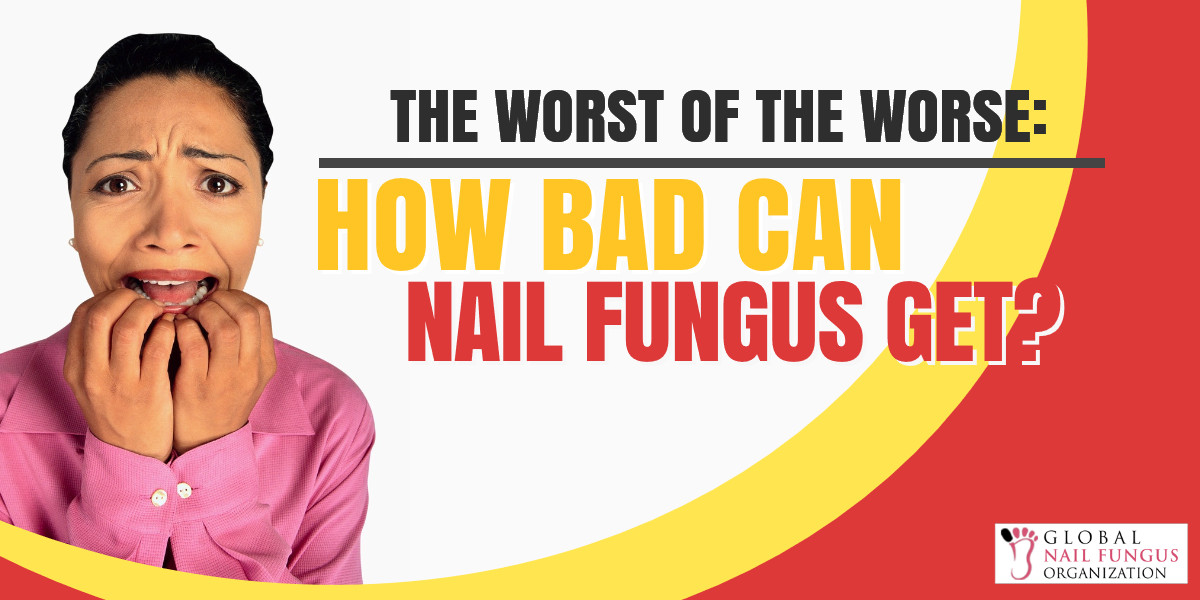 The Worst of the Worst: How Bad Can Nail Fungus Get?
The Worst of the Worst: How Bad Can Nail Fungus Get?
Table of Contents
Introduction to the Different Types of Nail Fungus
Not all nail fungi are the same. There are four major types of nail fungus, each one named after the area where the infection starts. Depending on the type, the causes and the symptoms of each also differ. Discussed below are these different types. Read on for you to find out which one you might possible have.
Distal subungual onychomycosis (DSO)
The most common type of nail fungus, distal subungual onychomycosis (or DSO) affects about 80% of nail fungus sufferers. It is caused by the same dermatophytic fungi that cause athlete’s foot, called Trichophyton rubrum. DSO starts when the fungus infects the skin underneath the end of the nail, spreading through other parts of the nail and the nail bed.
The infection worsens with the nail growing thicker and the entire nail plate becoming discolored. The nail may also crumble and split, and the entire nail may be detached from its bed.
White superficial onychomycosis (WSO)
An uncommon type of nail fungus, white superficial onychomycosis (WSO) is caused by the presence of the dermatophyte Trichophyton mentagrophytes, which attack the superficial layers of the nail, first forming white spots on the surface. As the fungus spreads, the white spots will cover the entire nail surface, which will result in crumbly powder.
Unlike DSO, WSO will not make the nail grow thicker and become disconnected from the skin. However, it will leave the nail plate deformed.
Candida onychomycosis (yeast infection)
This uncommon type of fungal infection may be painful for the sufferer. It starts around the cuticle and spreads to the skin surrounding the nail. This will weaken the nail, which will look thicker than normal and have signs of infection in the skin next to the nail fold. The nail may also become discolored and with an odd shape. Candida onychomycosis is more commonly found in fingernails than in toenails.
Proximal subungal onychomycosis (PSO)
PSO is also caused by dematophytes. The infection starts at the base of the nail, often thickening the surrounding skin and lifting the nail plate from its bed. The base of the nail will be covered in white, while the nail may look opaque. The infection may also spread to the skin on top of the foot.
This type of nail fungus is more common in people with human immunodeficiency virus (HIV).
What happens if Nail Fungus is left untreated?
For mild fungal nail infections, treatment is often topical solutions which are easy to obtain, have little to no side effects, and can remove infections in a short period of time. However, if these are left untreated, they may contribute to higher risks of bacterial infection or severe problems with the immune system.
Worst case of nail fungus
Nail fungus is often painless and may only affect one nail. However, there are some rare cases when sufferers experience pain and discomfort, as in the case of those with candida onychomycosis. Nails may also be discolored, become brittle, and even completely detached. The pain is due to the fungus affecting the skin itself, not just the nail.
Different Treatment Types for Nail Fungus
Topical medicines
Topical anti-fungal medicines are applied to the skin and nail area. One of the most effective topical solutions for nail fungus is 10% undecylenic acid, which works by preventing the growth of fungus. The effectiveness of most topical medicines is limited because they cannot penetrate the nail deeply enough to cure fungal nail infection. However, with the right combination of essential oils, there are some topical treatments that can easily penetrate the nail and get to the fungus itself.
Anti-fungal medications in pill form
Oral anti-fungal medications are recommended for moderate to severe fungal nail infections. Although considered effective, anti-fungal drugs have lower chances of success in adults over the age of 65. Also, they may bring side effects even to healthy people. Therefore, they are less likely to be recommended to people with liver disease, heart problems, or those who are pregnant.
Laser treatments
One of the newer and more expensive treatment options available today, laser therapy, or photodynamic therapy, uses light-activated agents onto the nail to destroy the fungus. In some cases, more than one laser treatment session is required.
Surgery
Surgery will get rid of the nail infection but may only provide temporary relief. As with other treatments, recurrence of the fungus is possible and even common. However, this option is preferred in severe nail fungus cases. Like laser treatments, this procedure is also quite costly and can cause side effects like abnormal nail growth and scarring if not done properly.
Essential oils
Some people take the natural remedies route in treating nail fungus. Some oils are said to have anti-fungal properties. They apply various oils like oil of cedar leaf and coconut oil to their nails in a bid to kill the fungus with all-natural products. However, the effectiveness of these oils alone are still up for debate. Most oils just soften the nail or skin. The softened nail makes people think that the infection has gone when in fact, the nail fungus itself is not affected and is still active within the nail.
How to prevent Nail Fungus from getting worse
Take care of own hygiene
Good hygiene can effectively reduce the risk of developing a nail fungal infection. Basic hygiene practices—such as regularly washing and drying hands and feet, avoiding walking barefoot in public pools and showers, and using own shoes and socks—can help avoid nail fungus infection.
Inspection of toes
Nail fungus can start with athlete’s foot (tinea pedis). Therefore, treating athlete’s foot as early as possible can reduce the risk of developing nail fungus. Some sufferers of athlete’s foot are not aware they have it until the symptoms have worsened. Inspection of toes and looking out for signs of athlete’s foot (i.e. itchy and scaling skin between the toes) may prevent the spreading of infection to the nail.
Be cautious of surroundings and equipment used
Oftentimes, sufferers got their nail fungus from public places, such as spa and nail salon, locker rooms, swimming pools, and public showers. Equipment and tools used in salons should be properly sterilized between uses to avoid the spreading of fungal infection. At communal facilities like pools and showers, it’s best to use proper footwear.
Conclusion: Treat Nail Fungus Before It Gets Worse
Mild nail fungus infection is oftentimes painless and not bothersome. However, if left untreated for a period of time, nail fungal infections can turn unsightly and, in rare and very severe cases, painful and uncomfortable.
Even the worst cases of nail fungus can easily be treated using different treatment options. The most recommended treatment for both mild and severe cases of nail fungus is a topical solution containing 10% undecylenic acid, a compound derived from castor oil that prevents fungus growth. This acid is approved by the FDA in the US. This treatment, combined with the right preventive measures, can help treat nail fungus and even prevent it from recurring.










